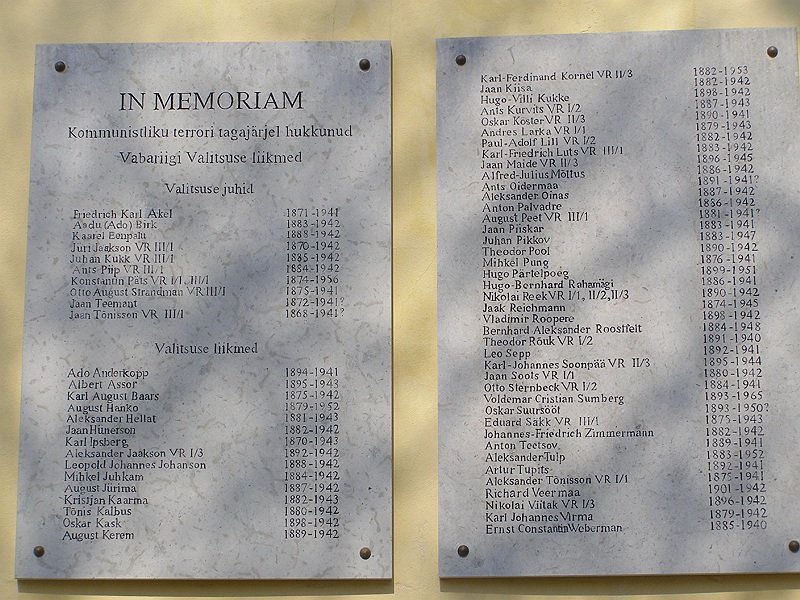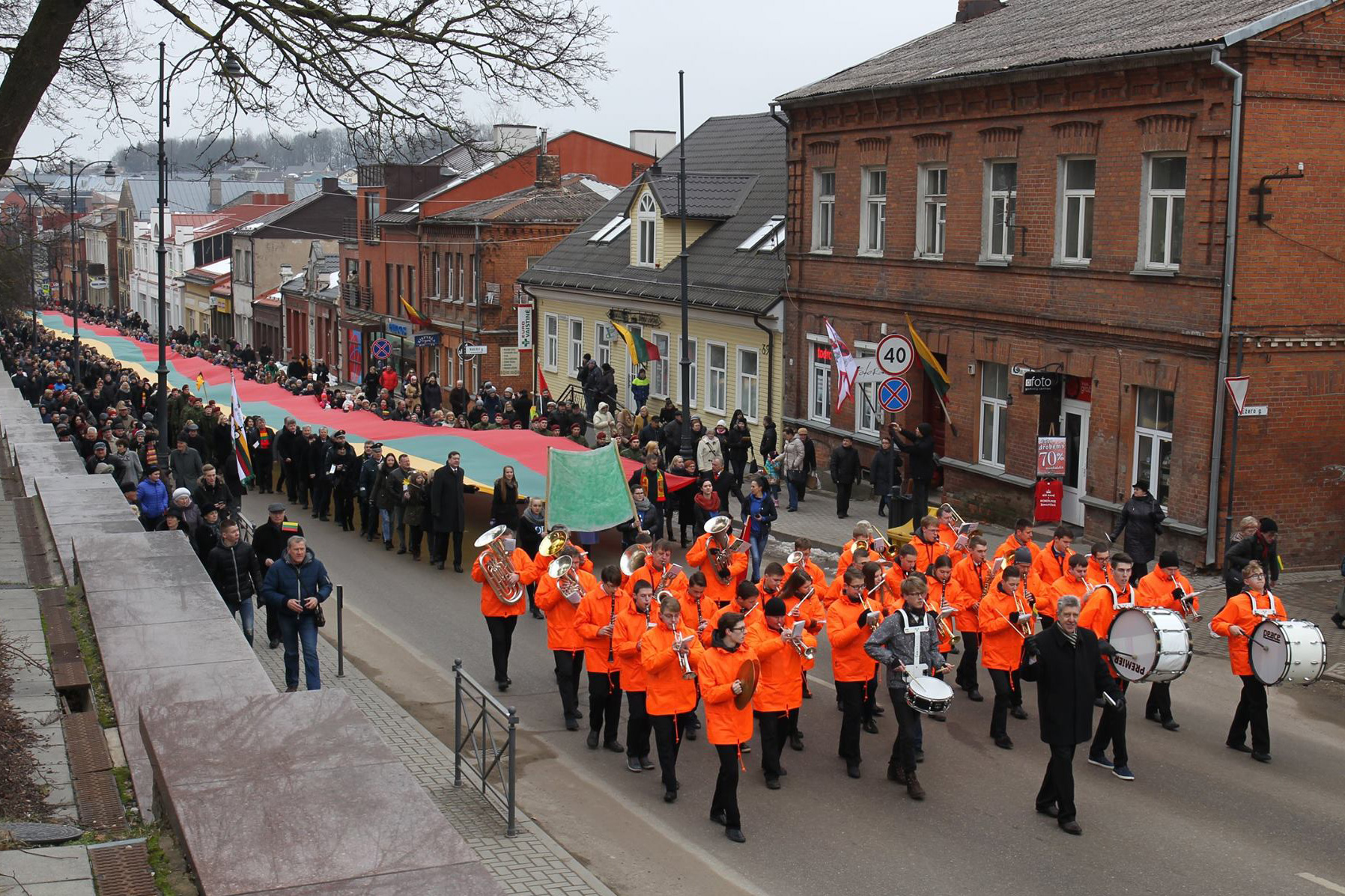|
Mečislovas Gedvilas
Mečislovas Gedvilas (19 October 1901 – 15 February 1981) was a Lithuanian Communist politician who collaborated with occupying Soviet forces. He served as the first Prime Minister of the Lithuanian SSR from 1940 to 1956. Rivalry between him and Antanas Sniečkus, the first secretary of the Lithuanian Communist Party, led to his demotion to Minister of Education (1957–1973). Early life and career Born at Bubiai in Kovno Governorate in 1901, Gedvilas and his family were deported to Russia for violation of the Lithuanian press ban in 1904. At first they moved to Rybinsk and then to Pavlovsk near Saint Petersburg. Gedvilas studied at the Saint Petersburg State Institute of Technology from 1919 to 1922. After returning to Lithuania he worked as a teacher of algebra, geometry, bookkeeping in Palanga (1923–1927) but was dismissed for not having any pedagogical education or qualifications. He supported left-wing political organizations and publications. In 1926, he joined the Lith ... [...More Info...] [...Related Items...] OR: [Wikipedia] [Google] [Baidu] [Amazon] |
Kovno Governorate
Kovno Governorate was an administrative-territorial unit (''guberniya'') of the Russian Empire, with its capital in Kovno (Kaunas). It was formed on 18 December 1842 by Tsar Nicholas I of Russia, Nicholas I from the western part of Vilna Governorate, and the order was carried out on 1 July 1843. It was part of the Vilna Governorate-General and Northwestern Krai. The governorate included almost the entire Lithuanian region of Samogitia and the northern part of Aukštaitija. Counties The governorate was divided into seven uyezds: Notes References Further reading * * Kovno Governorate, Governorates of the Russian Empire History of Kaunas Historical regions in Lithuania 1843 establishments in the Russian Empire {{Russia-hist-stub ... [...More Info...] [...Related Items...] OR: [Wikipedia] [Google] [Baidu] [Amazon] |
Rybinsk
Rybinsk (, ) is the second-largest types of inhabited localities in Russia, city of Yaroslavl Oblast in Russia. It lies at the confluence of the Volga and Sheksna rivers, north-north-east of Moscow. Population: It was previously known as ''Ust-Sheksna'' (until 1504), ''Rybnaya Sloboda'' (until 1777), ''Shcherbakov'' (1946–1957), and ''Andropov'' (1984–1989). History Early history Rybinsk is one of the oldest Slavic settlements on the Volga River. The place was first recorded by chroniclers in 1071 as Ust-Sheksna, i.e. "the mouth of the Sheksna". During this period the settlement was a regional center for craft and metal based produce and for trade. In the mid-13th century, Ust-Sheksna was laid waste by Mongol invasion of Rus', invading Mongols. For the next few centuries, the settlement was referred to alternatively as Ust-Sheksna or Rybansk. From 1504, it was identified in documents as Rybnaya Sloboda (literally: "the fishing village"). The name is explained by the f ... [...More Info...] [...Related Items...] OR: [Wikipedia] [Google] [Baidu] [Amazon] |
Sovietization Of The Baltic States
The Sovietization of the Baltic states is the sovietization of all spheres of life in Estonia, Latvia and Lithuania when they were under control of the Soviet Union. The first period deals with the occupation from June 1940 to July 1941, followed by the German occupation during World War II. The second period of occupation covers 1944 when the Soviet forces pushed the Germans out, until the end of the Soviet occupation in 1991 when the three countries restored full independence. Following the Soviet invasion of the Baltic states in June 1940, repressive measures were enforced in these countries, including arrests, executions and mass deportations, in accordance with the Serov Instructions. Thousands of opposants and their families were arrested and deported to eliminate any political and social opposition. Rigged elections led the Communist Party to power, and the three countries incorporated the Soviet Union. After the German occupation, the Soviet Union reoccupied the Balti ... [...More Info...] [...Related Items...] OR: [Wikipedia] [Google] [Baidu] [Amazon] |
People's Seimas
The People's Seimas () was a puppet legislature organized in order to give legal sanction to the occupation and annexation of Lithuania by the Soviet Union. After the Soviet ultimatum in June 1940, a new pro-Soviet government was formed, known as the People's Government. The new government dismissed the Fourth Seimas and announced elections to the People's Seimas. The elections were heavily rigged, and resulted in a chamber composed entirely of Communists and Communist sympathizers (the electorate had no choice as 79 candidates were offered to the 79 seats). The new parliament unanimously adopted a resolution proclaiming the Lithuanian Soviet Socialist Republic and petitioned for admission to the Soviet Union as a constituent republic. The Supreme Soviet of the USSR accepted the Lithuanian petition on 3 August 1940. The People's Seimas adopted a new constitution, a close copy of the 1936 Soviet Constitution, on 25 August and renamed itself to the Supreme Soviet of the Lithuania ... [...More Info...] [...Related Items...] OR: [Wikipedia] [Google] [Baidu] [Amazon] |
People's Government Of Lithuania
The People's Government of Lithuania () was a puppet cabinet installed by the Soviet Union in Lithuania immediately after Lithuania's acceptance of the Soviet ultimatum of June 14, 1940. The formation of the cabinet was supervised by Vladimir Dekanozov, deputy of Vyacheslav Molotov and a close associate of Lavrentiy Beria, who selected Justas Paleckis as the prime minister and acting president. The government was formed on June 17 and, together with the People's Seimas (parliament), transitioned independent Lithuania to a socialist republic and the 14th republic of the Soviet Union thus legitimizing the Soviet occupation of Lithuania. The People's Government was replaced by the Council of People's Commissars of the Lithuanian SSR on August 25. Similar transitional People's Governments were formed in Latvia (Prime Minister Augusts Kirhenšteins supervised by Andrey Vyshinsky) and Estonia (Prime Minister Johannes Vares supervised by Andrei Zhdanov). Formation The Molotov–Ri ... [...More Info...] [...Related Items...] OR: [Wikipedia] [Google] [Baidu] [Amazon] |
1940 Soviet Ultimatum To Lithuania
The Soviet Union issued an ultimatum to Lithuania before midnight of 14 June 1940. The Soviets, using a formal pretext, demanded that an unspecified number of Soviet soldiers be allowed to enter the Lithuanian territory and that a new pro-Soviet government (later known as the " People's Government") be formed. The ultimatum and subsequent incorporation of Lithuania into the Soviet Union stemmed from the division of Eastern Europe into the German and Soviet spheres of influence agreed in the Molotov–Ribbentrop Pact of August 1939. Lithuania, along with Latvia and Estonia, fell into the Soviet sphere. According to the Soviet–Lithuanian Mutual Assistance Treaty of October 1939, Lithuania agreed to allow some 20,000 Soviets troops to be stationed at bases within Lithuania in exchange for receiving a portion of the Vilnius Region (previously Polish territory). Further Soviet actions to establish its dominance in its sphere of influence were delayed by the Winter War with Finland ... [...More Info...] [...Related Items...] OR: [Wikipedia] [Google] [Baidu] [Amazon] |
Antanas Smetona
Antanas Smetona (; 10 August 1874 – 9 January 1944) was a Lithuanian intellectual, journalist and politician. He served as the first president of Lithuania from 1919 to 1920 and later as the authoritarian head of state from 1926 until the Occupation of the Baltic states, Soviet occupation of Lithuania in 1940. Referred to as the "Leader of the Nation" during his presidency, Smetona is recognised as one of the most important Lithuanian political figures between World War I and World War II, and a prominent ideologist of Lithuanian National Revival, Lithuanian nationalism and the movement for national revival. Born into a farming family in the village of Užulėnis, Kovno Governorate, Smetona exhibited a strong interest in education and Lithuanian cultural identity from an early age. He attended Palanga Progymnasium and later graduated from Jelgava Gymnasium. He pursued higher education at the Saint Petersburg Imperial University, where he studied law and became involved in natio ... [...More Info...] [...Related Items...] OR: [Wikipedia] [Google] [Baidu] [Amazon] |
Telšiai
Telšiai (; Samogitian language, Samogitian: ''Telšē'') is a city in Lithuania with about 21,499 inhabitants. It is the capital of Telšiai County and Samogitia region, and it is located on the shores of Lake Mastis. Telšiai is one of the oldest cities in Lithuania, probably dating earlier than the 14th century. Between the 15th and 20th centuries, Telšiai became a district capital. Until 1795, Telšiai County formed the Duchy of Samogitia within the Grand Duchy of Lithuania. Between 1795 and 1802 it was included in the Vilnius Governorate. In 1873, Telšiai was transferred to the Kovno Governorate. Names The name Telšiai is a variant of the same Lithuanian language root (''-telš-'', ''-tilž-'') as Tilžė or Talsi with the meaning connected to water. The name Telšiai or Telšē in Samogitian dialect of Lithuanian is derived from a verb ''telkšoti'' (literally, ''to be flooded with water'', ''to splash'', etc.). It is a cognate to the Greek thalassa - ''sea'', compare ... [...More Info...] [...Related Items...] OR: [Wikipedia] [Google] [Baidu] [Amazon] |
Varniai Concentration Camp
Varniai concentration camp was an internment camp in Varniai, Lithuania. It was created a month after the coup d'état of December 1926 to house political prisoners, mostly members of the outlawed Communist Party of Lithuania. In total, more than 1,000 people passed through the camp before it was closed in 1931 due to financial difficulties brought by the Great Depression. Later, the authoritarian regime of Antanas Smetona operated two other internment camps, one in Dimitravas in 1936 and another in Pabradė in 1939. History In December 1926, Lithuanian military organized a coup to overthrow the democratically elected Lithuanian government of President Kazys Grinius and install Antanas Smetona and his Lithuanian Nationalist Union. The official rationale given by the military was that their actions had prevented an imminent Bolshevik coup, allegedly scheduled for 20 December. About 350 communists were arrested and four leaders (Karolis Požela, Juozas Greifenbergeris, Kazys Gie ... [...More Info...] [...Related Items...] OR: [Wikipedia] [Google] [Baidu] [Amazon] |
Tauragė Revolt
The Tauragė Revolt () was an anti-government revolt that took place in Tauragė, Lithuania on 9 September 1927. Members of the Social Democratic Party of Lithuania and Lithuanian Popular Peasants' Union wanted to remove President Antanas Smetona from power. The rebels took control of Tauragė, the revolt spread to neighboring villages and their forces grew to 200 men. However, the revolt was poorly prepared and was suppressed the same day by units of the Lithuanian Army that arrived from Klaipėda. In the aftermath, over 300 people were arrested and 11 were Capital punishment in Lithuania, executed. A group of rebels escaped abroad where they became known as ''plečkaitininkai'' and, with the help from Second Polish Republic, Poland, continued to plot against Smetona's regime until the mid-1930s. It was one of 13 attempts to overthrow Smetona's regime in 1926–1938. Background The revolt was the third attempt in less than a year to overthrow the government of President Antanas S ... [...More Info...] [...Related Items...] OR: [Wikipedia] [Google] [Baidu] [Amazon] |
Lithuanian Popular Peasants' Union
The Lithuanian Popular Peasants' Union (, LVLS) was a centre-left political party in Lithuania between 1922 and 1936. The party's leaders included the third President Kazys Grinius and three-term Prime Minister Mykolas Sleževičius. History The party was established in November 1922 by a merger of the Lithuanian Popular Socialist Democratic Party and the Peasant Union. At the time the two parties held a combined 19 seats, making it the largest in the Seimas. The new party emerged as the largest faction in the 1923 elections, winning 16 of the 78 seats. Nohlen, D & Stöver, P (2010) ''Elections in Europe: A data handbook'', p1218 The 1926 elections saw the party increase its seat tally to 22, remaining the largest party in the Seimas. From the 1920s, party internationally participated in the International Entente of Radical and Similar Democratic Parties. The LVLS formed a coalition government with the Social Democratic Party The name Social Democratic Party or Socia ... [...More Info...] [...Related Items...] OR: [Wikipedia] [Google] [Baidu] [Amazon] |




